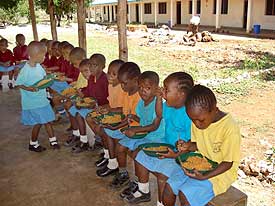Nursey
- ...the fifth year (2007)...
- It seemed our motto had almost magical powers! When we returned to Diani in January, we found that the kindergarten had, indeed, continued to progress. Our "perennial" issue was resolved: the toilets were finally in place and properly separated, in accordance with the law -- three in a "boys' room", and three in a "girls' room." So, we could welcome the local health authority with confidence.
Or so we thought! Yet again, another surprise awaited us. When the Public Health Office inspector spoke with Joshua and Edward, he was emphatic: the kindergarten would need a separate kitchen building with a proper fireplace, and an outside washing place for the children as well. Until this point, Miriam, our cook, had prepared the children's food in a small room within the kindergarten building. But it was not a proper kitchen, and ventilation was a problem. During meal preparation, the room would sometimes become smoky, making eyes water and breathing difficult.
So, without delay, we sought estimates and building plans to bring our kindergarten up to current construction codes. Despite our very tight schedule during this visit, we were able to meet with everyone involved and make the necessary decisions to proceed.
As demanded by law, the kitchen and the children's washing place were up and running in August.
However, this was not nearly the end of the "new" legal requirements. In June, our kindergarten received a visit from the inspector from the Ministry of Education. He was full of praise for the wonderful, clean toilets (so the toilet drama had been worthwhile!) and the pretty, bright classroom. Oh, yes, he said, everything was outstanding and fantastic - but….:
As with every kindergarten in Kenya, we had two classes: KG 1, for children between three and four years old, and KG 2, for children five and six years of age. Just as it is in Germany, KG 1 and KG 2 were taught together in one room. But, according to the inspector, the law required us to have a separate teacher for each kindergarten class.
We couldn't believe it! We had heard of overcrowded classrooms, with 70 or 80 pupils, all with one teacher. But at KiD, we had only 23 children total - could not one qualified educator manage this small number? No, said the inspector. The number of pupils was irrelevant - it mattered not if there were eight children or 50 in one kindergarten class: the law was concerned with the number of classes. If we had one class, we could serve any number of pupils with a single teacher. But we had two classes, so we had no choice but to find a second teacher.
So, we let others know we were seeking a second teacher and an English company "Reconstruct" agreed to pay the salary. Almost immediately, we received several applications. From these, Miriam, Joshua and Edward chose Agnes, who, like Miriam, has a teaching certificate. Agnes signed a probationary contract and now teaches the three- and four-year-old children from 7:00 in the morning till 13:00. In addition, every day from 18:30 to 20:30, Agnes tutors those who have already left kindergarten and gone on to primary school, and helps them with their homework.
Yes, at first the need for two teachers seemed excessive for our small school. Now, though, we are proud to have two such qualified teachers to give our children a good start and help them progress through their later schooling.
We had more good news during this period.
First, our little Rehema, the girl who received reconstructive surgery for her burns, had improved so much by this time that she was (and is) able to move and play without noticeable discomfort. We are all grateful for this positive outcome.
Further, we were able to purchase new furniture for the school. Now the office area has a real desk, chairs and lockable cabinet for the children's files. And more exciting, from the children's perspective: each child now has his or her own chair, and can share tables in pairs. The children love knowing where they "belong"!
Of course, the children especially love having a place to run free, to be kids! So they were even more excited than the adults when we completed work on the playground. When lessons are finished, they swarm onto the wonderful, soft sand that replaced the original surface of sharp coral rock. They can enjoy running, jumping and playing with car without fear of injury from a hard landing on gravel.
We had also completed the covered dining area, so the children could eat in the shade. And they could eat the very freshest, tastiest eggs, collected from the new henhouse.
In January, seven children left the kindergarten to move up to the elementary school. It was a proud moment for them, when Joshua presented them with their uniforms for the "big kid" school. This left seven open slots at KiD - slots that were immediately filled by Fridah, Leah, Millicent, Nancy, Silvia, Tony and Solomon, all eager to start their exciting kindergarten life.
Our increasing enrolment meant that, yet again, we had to deal with the matter of finances.
We had spent a good deal of time thinking about how KiD could pay for itself with local funding. Joshua and Edward approached other local parents who were in a financially strong position to ask them to consider enrolling their children in KiD and paying tuition (which we had never asked from the families of our poorer children). Some were able to do so, and eagerly registered their children. By mid-year, the tuition plan (for those who could pay) was in place, relieving us of the need to raise 100% of the funding.
Of course, our top priority was (and is) to educate children who are poor and unlikely to receive a good education otherwise. However, we welcomed the mix of children from different social strata as it created a truer sense of community among the 23 children then enrolled in the kindergarten.
Parental involvement continued to grow. Every Saturday, mothers and fathers had begun to meet every to clean the school and outbuildings and to tidy the lot. This included window washing, toilet cleaning and any other manner of cleaning.
In addition, an artistically talented Diani resident lovingly painted a large, colorful mural of the fabled Bremen Town Musicians on the front of the building. The children love the mural, and we are honoured by this beautiful tribute to KiD's connection with Bremen.
Bit by bit, an overgrown piece of wasteland has turned into a wonderful plot with pretty buildings full of liveliness and laughter. We hope to keep and conserve what we have achieved. But, in keeping with our motto, forward EVER means new issues, and the need for new ideas to address them. For example, we must solve our transportation problem (the need for our own vehicle), and we also plan, one day, for the kindergarten to pay for itself. We won't "wait and see" - we will approach these issues head on!
And someday, perhaps, if the next building inspector for Diani enrols his or her children at KiD, we will always be able to anticipate the building code changes that lie ahead!
KiD's motto is:
Forward EVER - Backward NEVER!
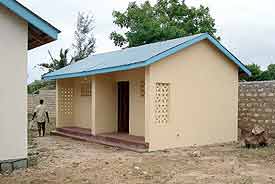
- The children's new toilet building - girls' room to the left, and boys' room at right.

- The new kitchen: the cooking room to the left, the store room to the right. In front: the washing area for the children.
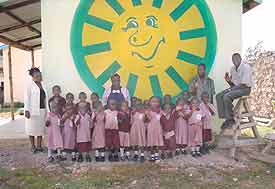
- Just outside the kitchen, back row, from left to right: Agnes, the new teacher, Miriam (our cook), Miriam (the "old" teacher), and Edward. In the foreground: our whole gang of "rascals."
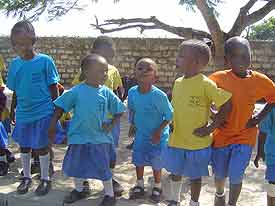 Our children spend every spare second on their new playground.
Our children spend every spare second on their new playground. 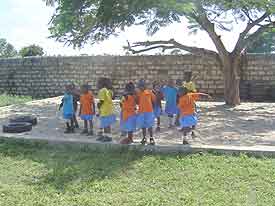
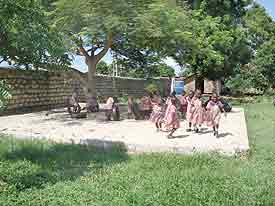
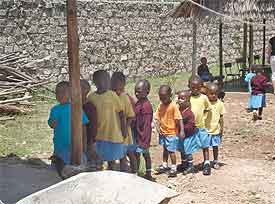
Mealtime. The children line up to get their meals from the kitchen. Then, it's off to the dining corner for lunch and a chat.
